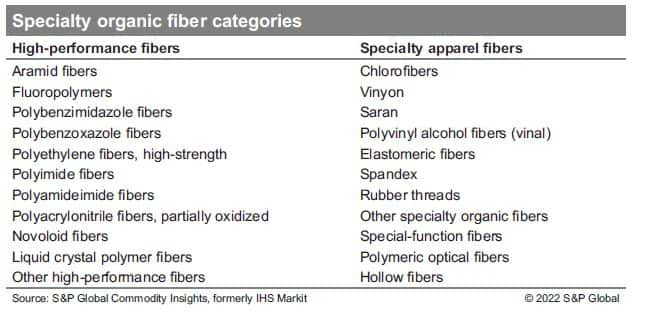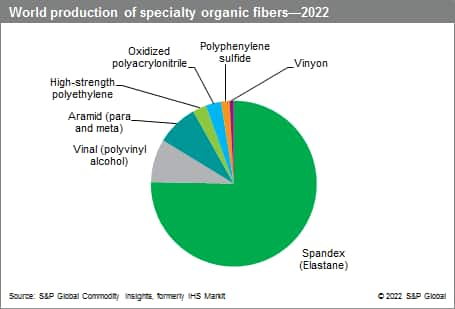Published November 2022
This report covers organic fibers used in specialty high-performance, textile, or functional applications. Highperformance fibers are generally characterized by their outstanding tensile strength and stiffness (modulus), as well as resistance to heat, fire, and chemical agents that normally degrade conventional fibers. Applications include use in aerospace, biomedical, civil engineering, construction, protective apparel, geotextiles, and electronics. Most of the organic fibers covered in this report are made by a limited number of producers; sometimes there is just one global producer. Global demand can be as low as a few hundred metric tons per year, and some fibers are only produced in pilot plant operations. These fibers usually require expensive raw materials made by a limited number of producers.
Specialty organic fibers generally possess one or more of the following properties:
- Excellent fire resistance
- Superior thermal resistance
- Good chemical resistance
- Excellent wear resistance
- High modulus and/or high strength
- Light weight
Each type of specialty organic fiber covered in the report is classified under one of the following general categories:

Within each of these general categories, individual fibers are presented in descending order of economic importance.
The following pie chart shows world production of the major specialty organic fibers (volume basis):

Overall, these high-performance fibers will continue to have relatively good demand in the next several years. For example, aramid fiber consumption is expected to increase at about 6% per year during the next five years, with even higher growth in mainland China. Likewise, high-strength polyethylene fiber consumption is anticipated to have annual growth of 4–5%, driven by use in ballistic materials, industrial fabrics, composite reinforcements, and ropes and cables.
Ballistic protection is one of the more important growing sectors, where para-aramid (e.g., Kevlar® and Twaron®) and high-strength polyethylene fibers are used. Demand has increased strongly during the 2000s as a result of greater concern over terrorist attacks and the US military involvement in the Middle East. Although the United States will continue to withdraw troops from this region, the government will also continue military spending to combat other terrorist groups, and bolster other programs around the world. This military action should continue to support the growth of such fibers.
Several other niche areas where these fibers are used include fire-protective clothing/fire-protection apparel, hot gas filtration media, aircraft brakes, optical fibers, dialyzers, and special consumer apparel.
For more detailed information, see the table of contents, shown below.
IHS Markit’s Chemical Economics Handbook – Fibers, Specialty Organic is the comprehensive and trusted guide for anyone seeking information on this industry. This latest report details global and regional information, including

Key Benefits
IHS Markit’s Chemical Economics Handbook – Fibers, Specialty Organic has been compiled using primary interviews with key suppliers, organizations and leading representatives from the industry in combination with IHS Markit’s unparalleled access to upstream and downstream market intelligence, expert insights into industry dynamics, trade and economics.
This report can help you:
- Identify trends and driving forces influencing chemical markets
- Forecast and plan for future demand
- Understand the impact of competing materials
- Identify and evaluate potential customers and competitors
- Evaluate producers
- Track changing prices and trade movements
- Analyze the impact of feedstocks, regulations, and other factors on chemical profitability


















